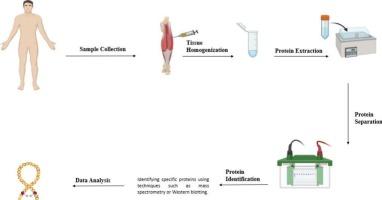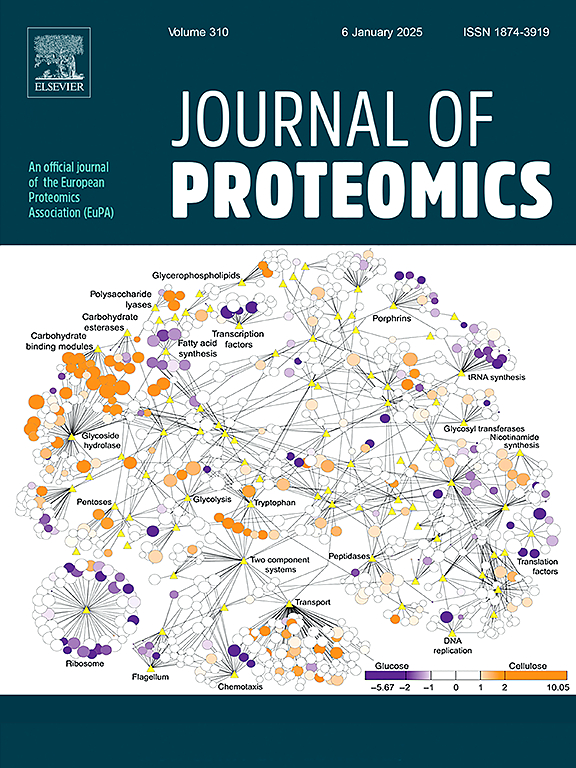蛋白质降解模式作为死后间隔估计的生物标志物:法医学蛋白质组学方法综述。
IF 2.8
2区 生物学
Q2 BIOCHEMICAL RESEARCH METHODS
引用次数: 0
摘要
确定死后间隔(PMI)是法医法律调查的一个关键过程。蛋白质组技术在分析法医生物样本方面的作用日益突出。人死后,研究人体内的蛋白质对于发现重要的新生物标记物至关重要,这些标记物可作为各种因素的可靠指标。本研究利用 PubMed、NCBI、SCOPUS、Research Gate、Science Direct 和 Google Scholar 对通过蛋白质降解分析估计 PMI 进行了文献综述。共发现并研究了 32 项研究。研究发现,最常研究的组织类型是骨骼肌(15 项研究),其次是其他组织。几种蛋白质和蛋白酶的动力学与 PMI 尤为相关。不同的蛋白质在死亡后的降解方式不同:α-肌动蛋白、GAPDH 和α-微管蛋白的分解速度较慢,而元肌球蛋白的分解速度较快。肌球蛋白在死亡后很长一段时间(长达 10 天)都不会发生变化。某些标记物与 PMI 呈正相关,即随着 PMI 小时数的增加,其数量也会增加,而其他标记物则呈负相关,表明其数量会随着时间的推移而减少。随着 PMI 的增加,SERBP1、COX7B 和 SOD2 等几种生物标记物的水平逐渐发生持续变化。本分析收集的信息为在法律背景下精确测量 PMI 提供了新的机会,扩大了该研究领域在人体骨骼组织中的应用。本文章由计算机程序翻译,如有差异,请以英文原文为准。

Protein degradation patterns as biomarkers for post-mortem interval estimation: A comprehensive review of proteomic approaches in forensic science
The determination of post-mortem interval (PMI) is a critical process for forensic medical-legal investigations. Proteomic techniques are gaining prominence in analysing forensic biological samples. After death, studying the proteins present in human bodies could be critical in discovering important new biomarkers that can serve as reliable indicators of various factors. A literature review is conducted on estimating PMI through protein degradation analysis using PubMed, NCBI, SCOPUS, Research Gate, Science Direct, and Google Scholar. A total of 32 studies were identified and studied. It is found that the most commonly studied tissue type is the skeleton muscle (15 studies), followed by others. The kinetics of several proteins and proteases were particularly correlated with PMI. Different proteins degrade differently after death: alpha-actinin, GAPDH, and alpha-tubulin breakdown slowly, but meta-vinculin breaks down early. Tropomyosin does not change for a long time after death, up to 10 days. Certain markers had a positive correlation with PMI, meaning that their amount increased as PMI hours increased, while other markers showed a negative correlation, suggesting that their number decreased with time. The level of several biological markers, such as SERBP1, COX7B, and SOD2, changed gradually and consistently as the PMI increased. The information gathered from this analysis provides new opportunities for precise PMI measurements in legal contexts by expanding the research area's use in human skeletal tissue.
求助全文
通过发布文献求助,成功后即可免费获取论文全文。
去求助
来源期刊

Journal of proteomics
生物-生化研究方法
CiteScore
7.10
自引率
3.00%
发文量
227
审稿时长
73 days
期刊介绍:
Journal of Proteomics is aimed at protein scientists and analytical chemists in the field of proteomics, biomarker discovery, protein analytics, plant proteomics, microbial and animal proteomics, human studies, tissue imaging by mass spectrometry, non-conventional and non-model organism proteomics, and protein bioinformatics. The journal welcomes papers in new and upcoming areas such as metabolomics, genomics, systems biology, toxicogenomics, pharmacoproteomics.
Journal of Proteomics unifies both fundamental scientists and clinicians, and includes translational research. Suggestions for reviews, webinars and thematic issues are welcome.
 求助内容:
求助内容: 应助结果提醒方式:
应助结果提醒方式:


